Financial Resource Management and Decision Making Report - University
VerifiedAdded on 2020/02/05
|18
|4678
|50
Report
AI Summary
This report provides a comprehensive analysis of financial resource management and decision-making within a business context. It begins by identifying and assessing various sources of finance, including internal and external options such as personal capital, retained earnings, share issues, debentures, bank loans, venture capital, and government grants. The report evaluates the implications of each source, considering legal aspects, ownership dilution, and potential bankruptcy risks. It then analyzes the costs associated with each financing option, emphasizing the importance of financial planning, budgeting, and forecasting. The report further explores the information needs of internal and external decision-makers, including shareholders, investors, government entities, and financial institutions. It examines the impact of finance on financial statements and delves into financial ratio analysis, using J Sainsbury Plc as a case study to interpret financial statements and assess profitability, liquidity, efficiency, and investment performance. Finally, the report discusses projected budgets, unit cost calculations, pricing decisions, and the viability of a chosen contract using investment appraisal techniques, ultimately providing valuable insights into effective financial management strategies.
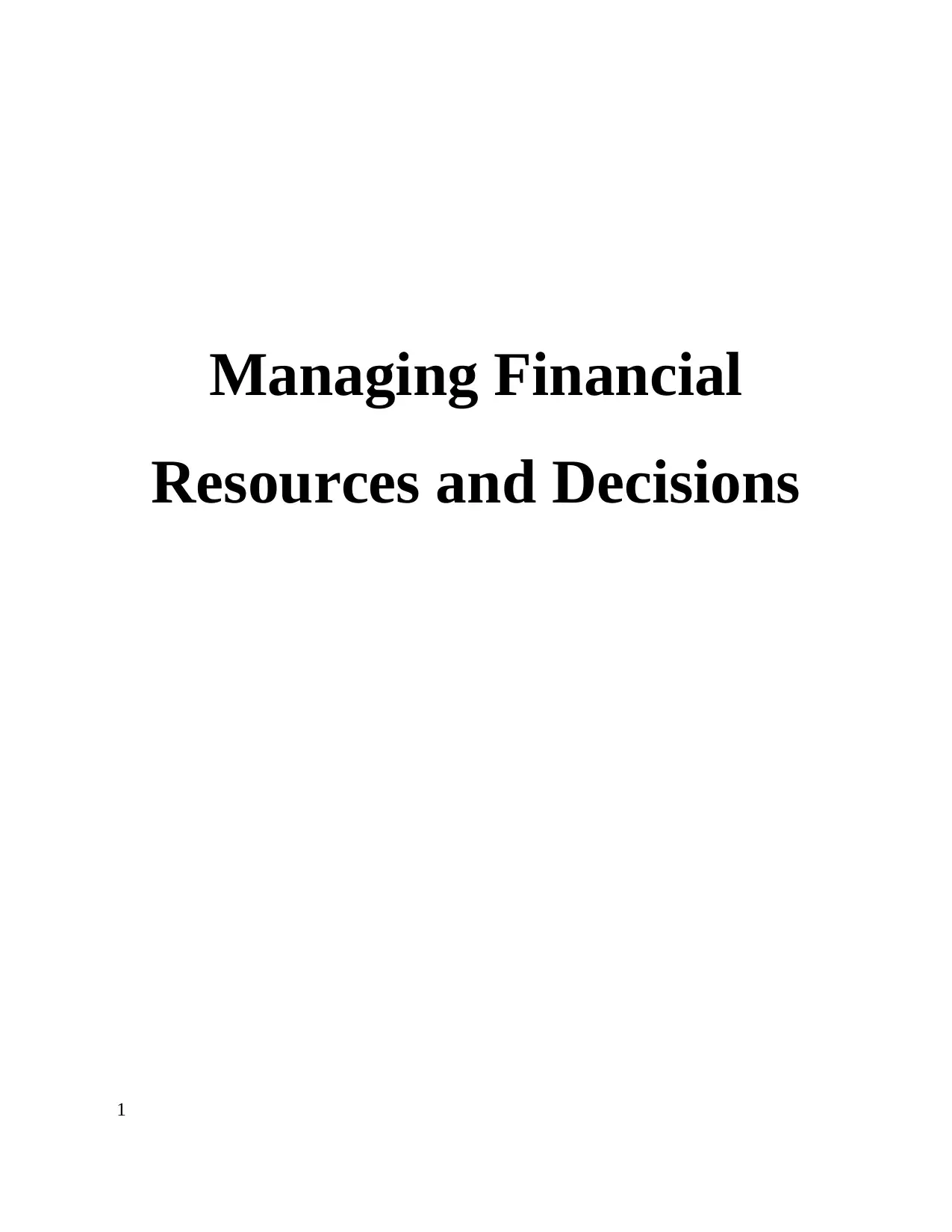
Managing Financial
Resources and Decisions
1
Resources and Decisions
1
Paraphrase This Document
Need a fresh take? Get an instant paraphrase of this document with our AI Paraphraser
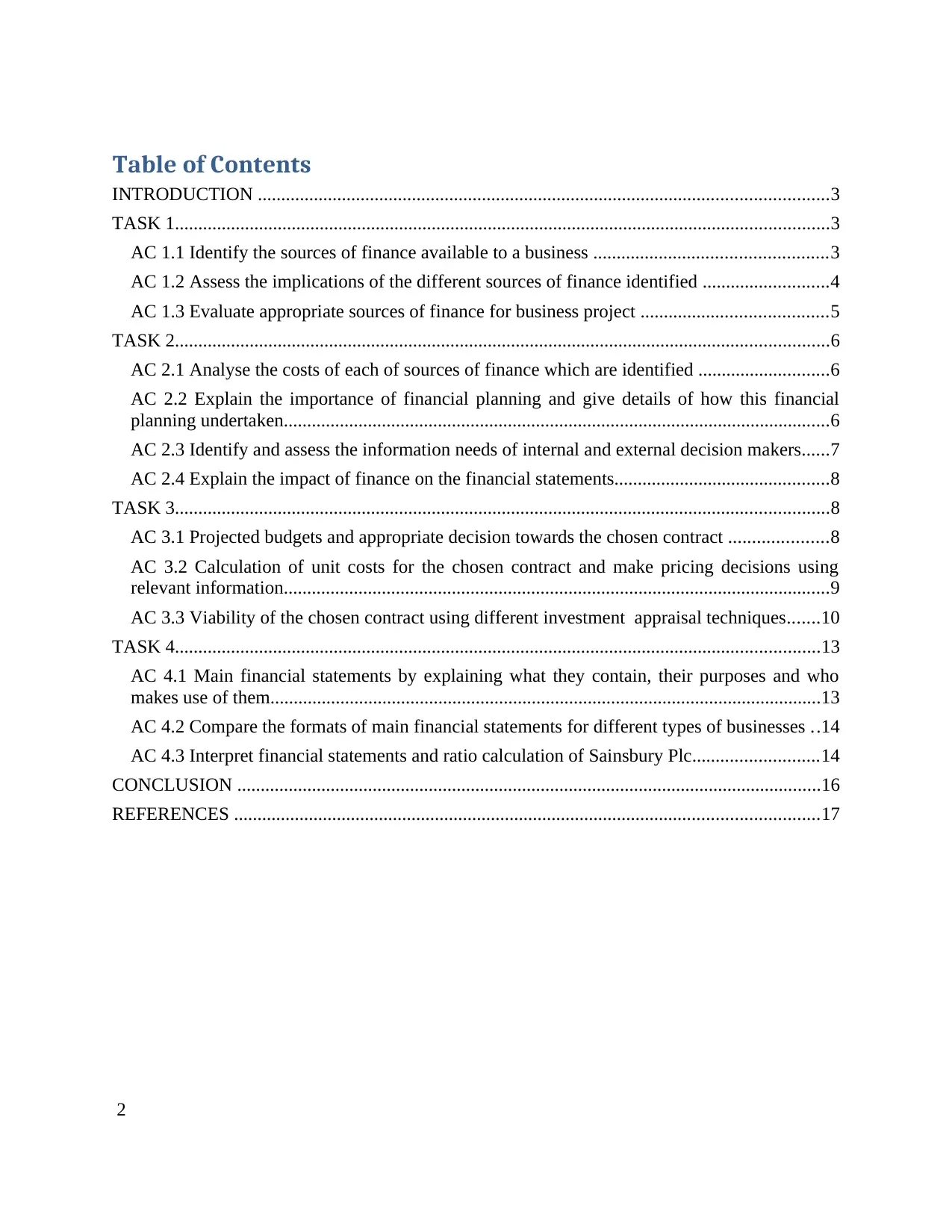
Table of Contents
INTRODUCTION ..........................................................................................................................3
TASK 1............................................................................................................................................3
AC 1.1 Identify the sources of finance available to a business ..................................................3
AC 1.2 Assess the implications of the different sources of finance identified ...........................4
AC 1.3 Evaluate appropriate sources of finance for business project ........................................5
TASK 2............................................................................................................................................6
AC 2.1 Analyse the costs of each of sources of finance which are identified ............................6
AC 2.2 Explain the importance of financial planning and give details of how this financial
planning undertaken.....................................................................................................................6
AC 2.3 Identify and assess the information needs of internal and external decision makers......7
AC 2.4 Explain the impact of finance on the financial statements..............................................8
TASK 3............................................................................................................................................8
AC 3.1 Projected budgets and appropriate decision towards the chosen contract .....................8
AC 3.2 Calculation of unit costs for the chosen contract and make pricing decisions using
relevant information.....................................................................................................................9
AC 3.3 Viability of the chosen contract using different investment appraisal techniques.......10
TASK 4..........................................................................................................................................13
AC 4.1 Main financial statements by explaining what they contain, their purposes and who
makes use of them......................................................................................................................13
AC 4.2 Compare the formats of main financial statements for different types of businesses ..14
AC 4.3 Interpret financial statements and ratio calculation of Sainsbury Plc...........................14
CONCLUSION .............................................................................................................................16
REFERENCES .............................................................................................................................17
2
INTRODUCTION ..........................................................................................................................3
TASK 1............................................................................................................................................3
AC 1.1 Identify the sources of finance available to a business ..................................................3
AC 1.2 Assess the implications of the different sources of finance identified ...........................4
AC 1.3 Evaluate appropriate sources of finance for business project ........................................5
TASK 2............................................................................................................................................6
AC 2.1 Analyse the costs of each of sources of finance which are identified ............................6
AC 2.2 Explain the importance of financial planning and give details of how this financial
planning undertaken.....................................................................................................................6
AC 2.3 Identify and assess the information needs of internal and external decision makers......7
AC 2.4 Explain the impact of finance on the financial statements..............................................8
TASK 3............................................................................................................................................8
AC 3.1 Projected budgets and appropriate decision towards the chosen contract .....................8
AC 3.2 Calculation of unit costs for the chosen contract and make pricing decisions using
relevant information.....................................................................................................................9
AC 3.3 Viability of the chosen contract using different investment appraisal techniques.......10
TASK 4..........................................................................................................................................13
AC 4.1 Main financial statements by explaining what they contain, their purposes and who
makes use of them......................................................................................................................13
AC 4.2 Compare the formats of main financial statements for different types of businesses ..14
AC 4.3 Interpret financial statements and ratio calculation of Sainsbury Plc...........................14
CONCLUSION .............................................................................................................................16
REFERENCES .............................................................................................................................17
2
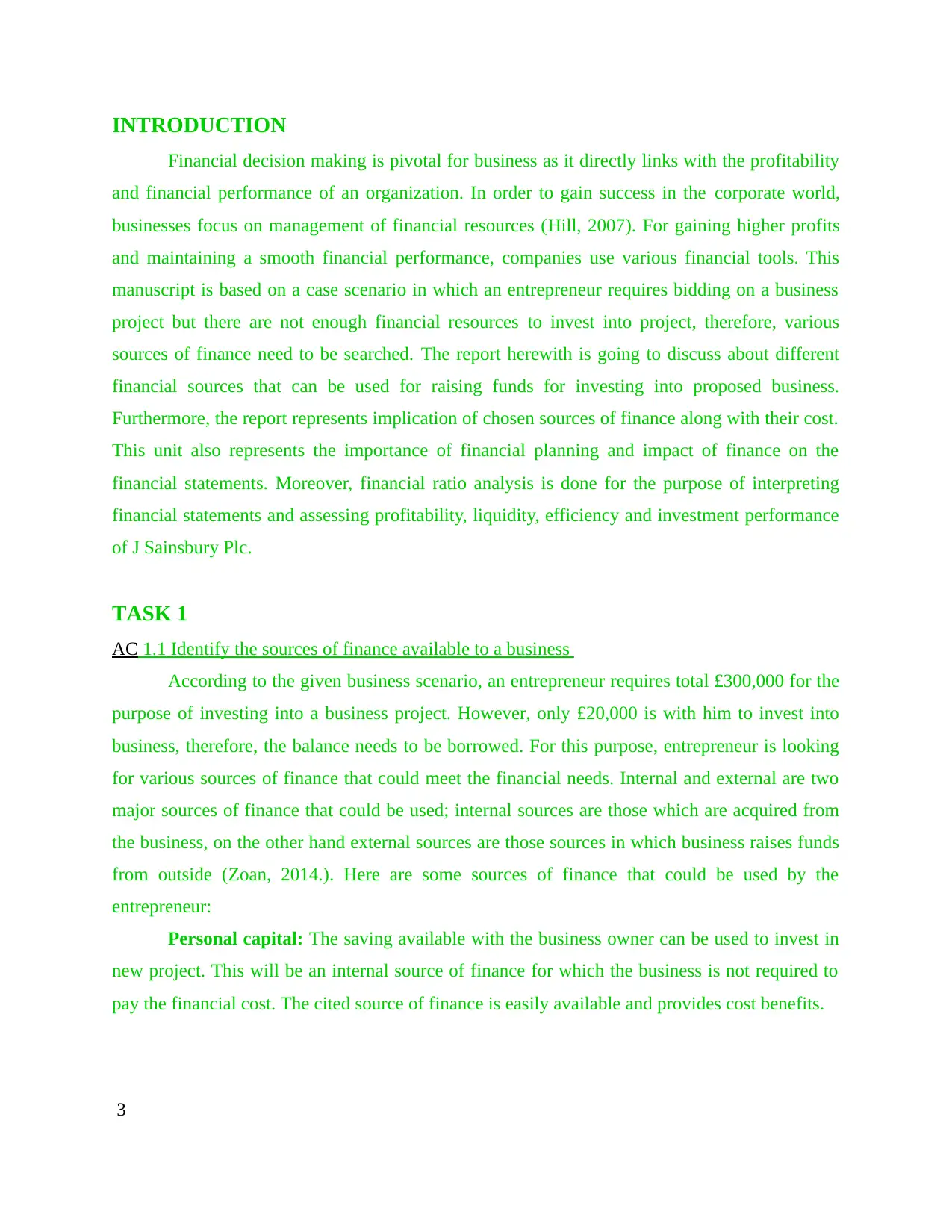
INTRODUCTION
Financial decision making is pivotal for business as it directly links with the profitability
and financial performance of an organization. In order to gain success in the corporate world,
businesses focus on management of financial resources (Hill, 2007). For gaining higher profits
and maintaining a smooth financial performance, companies use various financial tools. This
manuscript is based on a case scenario in which an entrepreneur requires bidding on a business
project but there are not enough financial resources to invest into project, therefore, various
sources of finance need to be searched. The report herewith is going to discuss about different
financial sources that can be used for raising funds for investing into proposed business.
Furthermore, the report represents implication of chosen sources of finance along with their cost.
This unit also represents the importance of financial planning and impact of finance on the
financial statements. Moreover, financial ratio analysis is done for the purpose of interpreting
financial statements and assessing profitability, liquidity, efficiency and investment performance
of J Sainsbury Plc.
TASK 1
AC 1.1 Identify the sources of finance available to a business
According to the given business scenario, an entrepreneur requires total £300,000 for the
purpose of investing into a business project. However, only £20,000 is with him to invest into
business, therefore, the balance needs to be borrowed. For this purpose, entrepreneur is looking
for various sources of finance that could meet the financial needs. Internal and external are two
major sources of finance that could be used; internal sources are those which are acquired from
the business, on the other hand external sources are those sources in which business raises funds
from outside (Zoan, 2014.). Here are some sources of finance that could be used by the
entrepreneur:
Personal capital: The saving available with the business owner can be used to invest in
new project. This will be an internal source of finance for which the business is not required to
pay the financial cost. The cited source of finance is easily available and provides cost benefits.
3
Financial decision making is pivotal for business as it directly links with the profitability
and financial performance of an organization. In order to gain success in the corporate world,
businesses focus on management of financial resources (Hill, 2007). For gaining higher profits
and maintaining a smooth financial performance, companies use various financial tools. This
manuscript is based on a case scenario in which an entrepreneur requires bidding on a business
project but there are not enough financial resources to invest into project, therefore, various
sources of finance need to be searched. The report herewith is going to discuss about different
financial sources that can be used for raising funds for investing into proposed business.
Furthermore, the report represents implication of chosen sources of finance along with their cost.
This unit also represents the importance of financial planning and impact of finance on the
financial statements. Moreover, financial ratio analysis is done for the purpose of interpreting
financial statements and assessing profitability, liquidity, efficiency and investment performance
of J Sainsbury Plc.
TASK 1
AC 1.1 Identify the sources of finance available to a business
According to the given business scenario, an entrepreneur requires total £300,000 for the
purpose of investing into a business project. However, only £20,000 is with him to invest into
business, therefore, the balance needs to be borrowed. For this purpose, entrepreneur is looking
for various sources of finance that could meet the financial needs. Internal and external are two
major sources of finance that could be used; internal sources are those which are acquired from
the business, on the other hand external sources are those sources in which business raises funds
from outside (Zoan, 2014.). Here are some sources of finance that could be used by the
entrepreneur:
Personal capital: The saving available with the business owner can be used to invest in
new project. This will be an internal source of finance for which the business is not required to
pay the financial cost. The cited source of finance is easily available and provides cost benefits.
3
⊘ This is a preview!⊘
Do you want full access?
Subscribe today to unlock all pages.

Trusted by 1+ million students worldwide
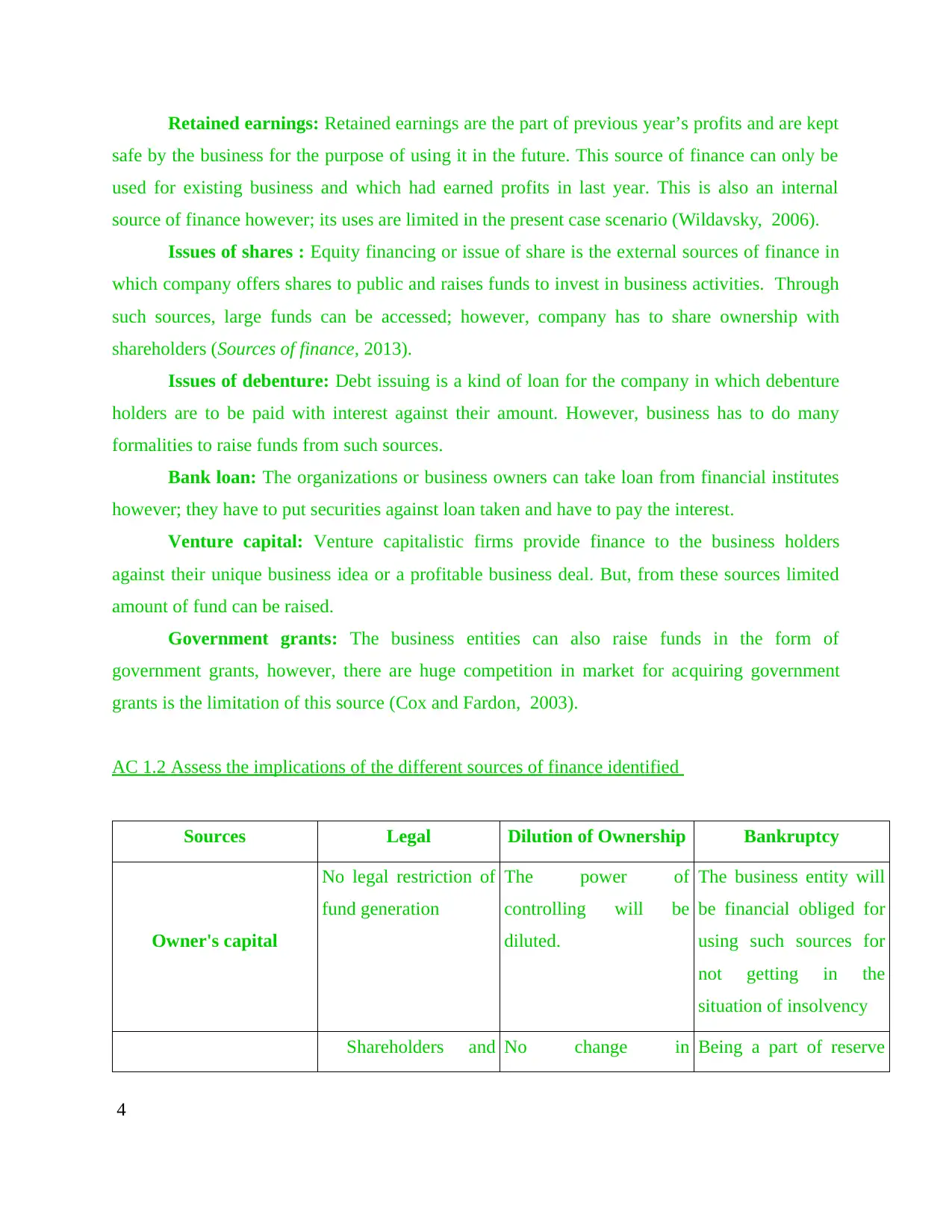
Retained earnings: Retained earnings are the part of previous year’s profits and are kept
safe by the business for the purpose of using it in the future. This source of finance can only be
used for existing business and which had earned profits in last year. This is also an internal
source of finance however; its uses are limited in the present case scenario (Wildavsky, 2006).
Issues of shares : Equity financing or issue of share is the external sources of finance in
which company offers shares to public and raises funds to invest in business activities. Through
such sources, large funds can be accessed; however, company has to share ownership with
shareholders (Sources of finance, 2013).
Issues of debenture: Debt issuing is a kind of loan for the company in which debenture
holders are to be paid with interest against their amount. However, business has to do many
formalities to raise funds from such sources.
Bank loan: The organizations or business owners can take loan from financial institutes
however; they have to put securities against loan taken and have to pay the interest.
Venture capital: Venture capitalistic firms provide finance to the business holders
against their unique business idea or a profitable business deal. But, from these sources limited
amount of fund can be raised.
Government grants: The business entities can also raise funds in the form of
government grants, however, there are huge competition in market for acquiring government
grants is the limitation of this source (Cox and Fardon, 2003).
AC 1.2 Assess the implications of the different sources of finance identified
Sources Legal Dilution of Ownership Bankruptcy
Owner's capital
No legal restriction of
fund generation
The power of
controlling will be
diluted.
The business entity will
be financial obliged for
using such sources for
not getting in the
situation of insolvency
Shareholders and No change in Being a part of reserve
4
safe by the business for the purpose of using it in the future. This source of finance can only be
used for existing business and which had earned profits in last year. This is also an internal
source of finance however; its uses are limited in the present case scenario (Wildavsky, 2006).
Issues of shares : Equity financing or issue of share is the external sources of finance in
which company offers shares to public and raises funds to invest in business activities. Through
such sources, large funds can be accessed; however, company has to share ownership with
shareholders (Sources of finance, 2013).
Issues of debenture: Debt issuing is a kind of loan for the company in which debenture
holders are to be paid with interest against their amount. However, business has to do many
formalities to raise funds from such sources.
Bank loan: The organizations or business owners can take loan from financial institutes
however; they have to put securities against loan taken and have to pay the interest.
Venture capital: Venture capitalistic firms provide finance to the business holders
against their unique business idea or a profitable business deal. But, from these sources limited
amount of fund can be raised.
Government grants: The business entities can also raise funds in the form of
government grants, however, there are huge competition in market for acquiring government
grants is the limitation of this source (Cox and Fardon, 2003).
AC 1.2 Assess the implications of the different sources of finance identified
Sources Legal Dilution of Ownership Bankruptcy
Owner's capital
No legal restriction of
fund generation
The power of
controlling will be
diluted.
The business entity will
be financial obliged for
using such sources for
not getting in the
situation of insolvency
Shareholders and No change in Being a part of reserve
4
Paraphrase This Document
Need a fresh take? Get an instant paraphrase of this document with our AI Paraphraser
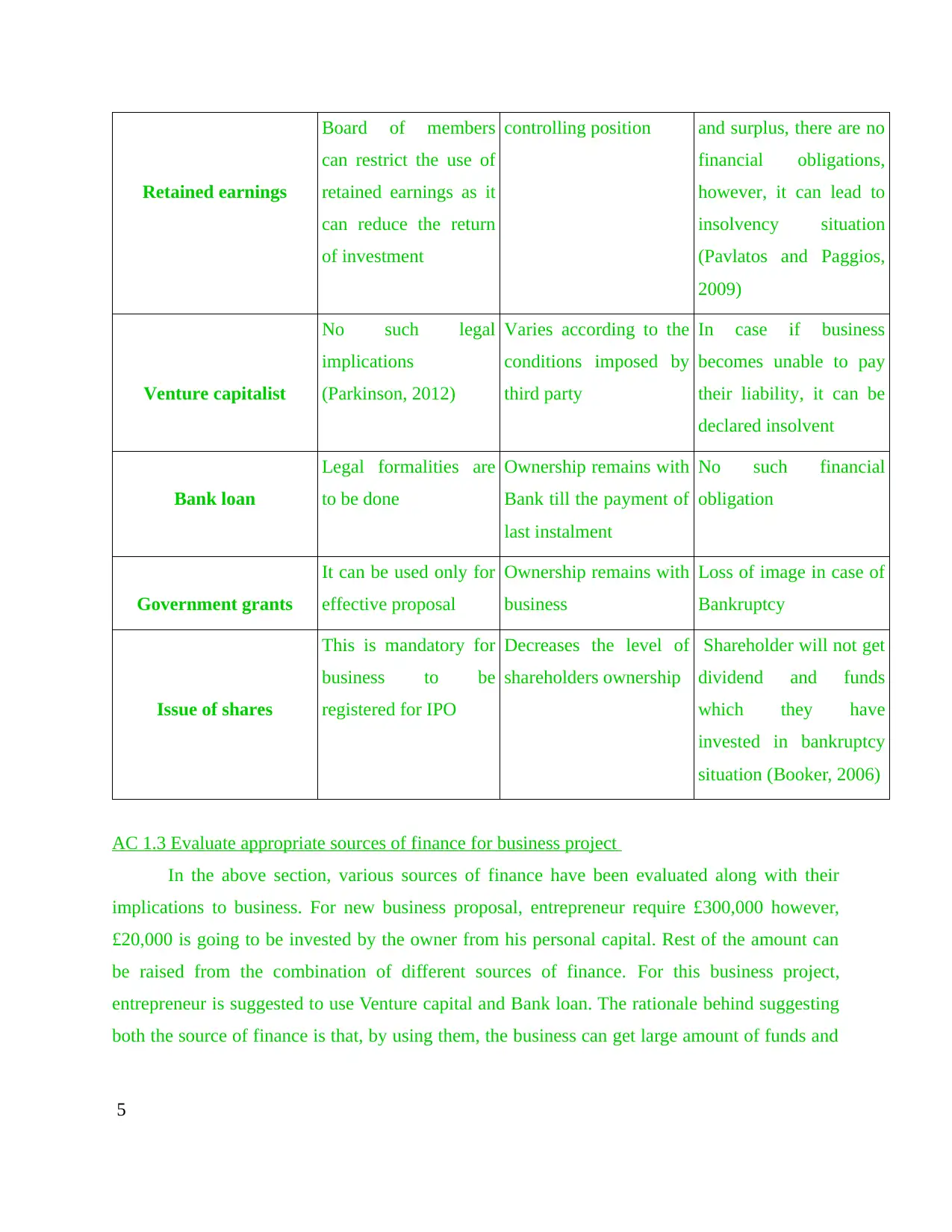
Retained earnings
Board of members
can restrict the use of
retained earnings as it
can reduce the return
of investment
controlling position and surplus, there are no
financial obligations,
however, it can lead to
insolvency situation
(Pavlatos and Paggios,
2009)
Venture capitalist
No such legal
implications
(Parkinson, 2012)
Varies according to the
conditions imposed by
third party
In case if business
becomes unable to pay
their liability, it can be
declared insolvent
Bank loan
Legal formalities are
to be done
Ownership remains with
Bank till the payment of
last instalment
No such financial
obligation
Government grants
It can be used only for
effective proposal
Ownership remains with
business
Loss of image in case of
Bankruptcy
Issue of shares
This is mandatory for
business to be
registered for IPO
Decreases the level of
shareholders ownership
Shareholder will not get
dividend and funds
which they have
invested in bankruptcy
situation (Booker, 2006)
AC 1.3 Evaluate appropriate sources of finance for business project
In the above section, various sources of finance have been evaluated along with their
implications to business. For new business proposal, entrepreneur require £300,000 however,
£20,000 is going to be invested by the owner from his personal capital. Rest of the amount can
be raised from the combination of different sources of finance. For this business project,
entrepreneur is suggested to use Venture capital and Bank loan. The rationale behind suggesting
both the source of finance is that, by using them, the business can get large amount of funds and
5
Board of members
can restrict the use of
retained earnings as it
can reduce the return
of investment
controlling position and surplus, there are no
financial obligations,
however, it can lead to
insolvency situation
(Pavlatos and Paggios,
2009)
Venture capitalist
No such legal
implications
(Parkinson, 2012)
Varies according to the
conditions imposed by
third party
In case if business
becomes unable to pay
their liability, it can be
declared insolvent
Bank loan
Legal formalities are
to be done
Ownership remains with
Bank till the payment of
last instalment
No such financial
obligation
Government grants
It can be used only for
effective proposal
Ownership remains with
business
Loss of image in case of
Bankruptcy
Issue of shares
This is mandatory for
business to be
registered for IPO
Decreases the level of
shareholders ownership
Shareholder will not get
dividend and funds
which they have
invested in bankruptcy
situation (Booker, 2006)
AC 1.3 Evaluate appropriate sources of finance for business project
In the above section, various sources of finance have been evaluated along with their
implications to business. For new business proposal, entrepreneur require £300,000 however,
£20,000 is going to be invested by the owner from his personal capital. Rest of the amount can
be raised from the combination of different sources of finance. For this business project,
entrepreneur is suggested to use Venture capital and Bank loan. The rationale behind suggesting
both the source of finance is that, by using them, the business can get large amount of funds and
5
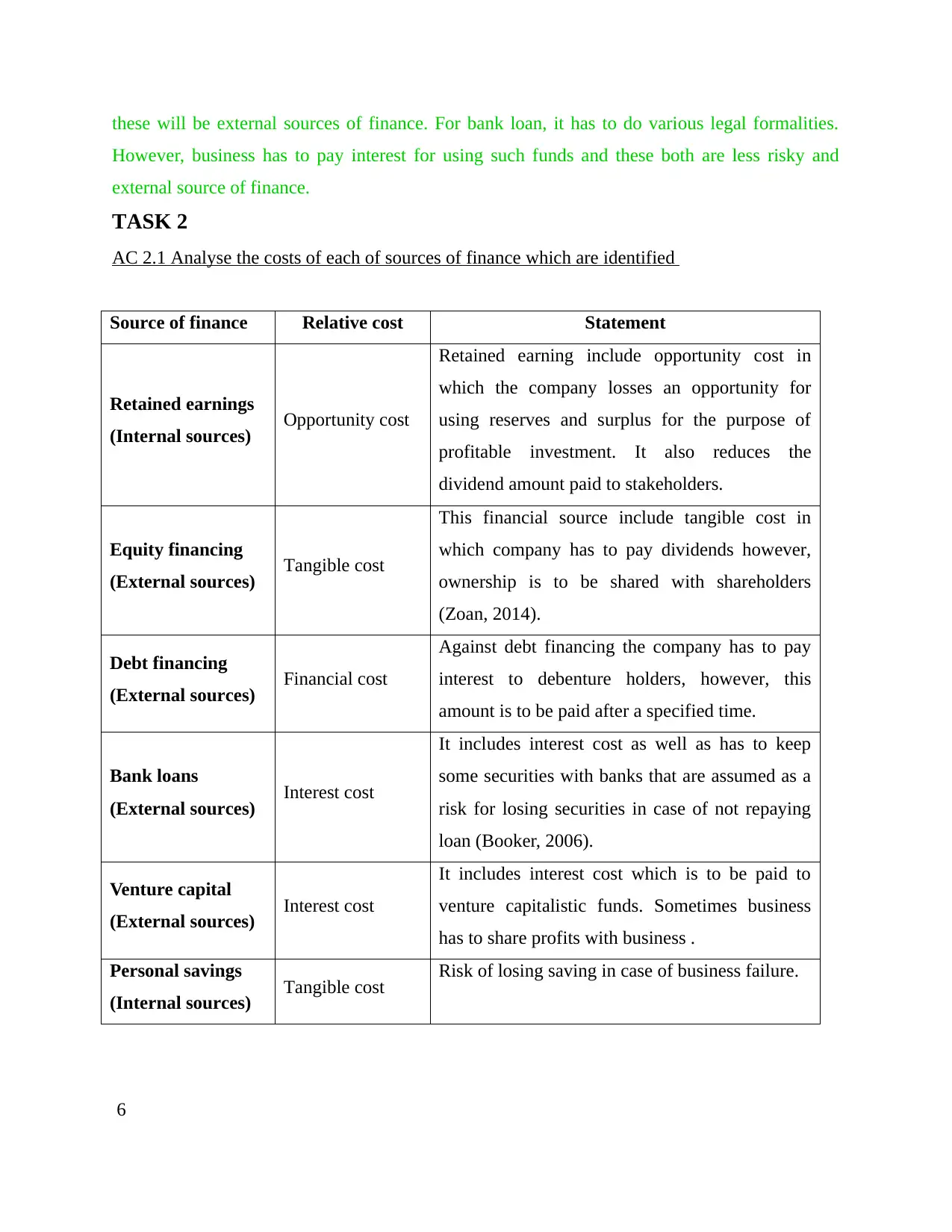
these will be external sources of finance. For bank loan, it has to do various legal formalities.
However, business has to pay interest for using such funds and these both are less risky and
external source of finance.
TASK 2
AC 2.1 Analyse the costs of each of sources of finance which are identified
Source of finance Relative cost Statement
Retained earnings
(Internal sources) Opportunity cost
Retained earning include opportunity cost in
which the company losses an opportunity for
using reserves and surplus for the purpose of
profitable investment. It also reduces the
dividend amount paid to stakeholders.
Equity financing
(External sources) Tangible cost
This financial source include tangible cost in
which company has to pay dividends however,
ownership is to be shared with shareholders
(Zoan, 2014).
Debt financing
(External sources) Financial cost
Against debt financing the company has to pay
interest to debenture holders, however, this
amount is to be paid after a specified time.
Bank loans
(External sources) Interest cost
It includes interest cost as well as has to keep
some securities with banks that are assumed as a
risk for losing securities in case of not repaying
loan (Booker, 2006).
Venture capital
(External sources) Interest cost
It includes interest cost which is to be paid to
venture capitalistic funds. Sometimes business
has to share profits with business .
Personal savings
(Internal sources) Tangible cost Risk of losing saving in case of business failure.
6
However, business has to pay interest for using such funds and these both are less risky and
external source of finance.
TASK 2
AC 2.1 Analyse the costs of each of sources of finance which are identified
Source of finance Relative cost Statement
Retained earnings
(Internal sources) Opportunity cost
Retained earning include opportunity cost in
which the company losses an opportunity for
using reserves and surplus for the purpose of
profitable investment. It also reduces the
dividend amount paid to stakeholders.
Equity financing
(External sources) Tangible cost
This financial source include tangible cost in
which company has to pay dividends however,
ownership is to be shared with shareholders
(Zoan, 2014).
Debt financing
(External sources) Financial cost
Against debt financing the company has to pay
interest to debenture holders, however, this
amount is to be paid after a specified time.
Bank loans
(External sources) Interest cost
It includes interest cost as well as has to keep
some securities with banks that are assumed as a
risk for losing securities in case of not repaying
loan (Booker, 2006).
Venture capital
(External sources) Interest cost
It includes interest cost which is to be paid to
venture capitalistic funds. Sometimes business
has to share profits with business .
Personal savings
(Internal sources) Tangible cost Risk of losing saving in case of business failure.
6
⊘ This is a preview!⊘
Do you want full access?
Subscribe today to unlock all pages.

Trusted by 1+ million students worldwide
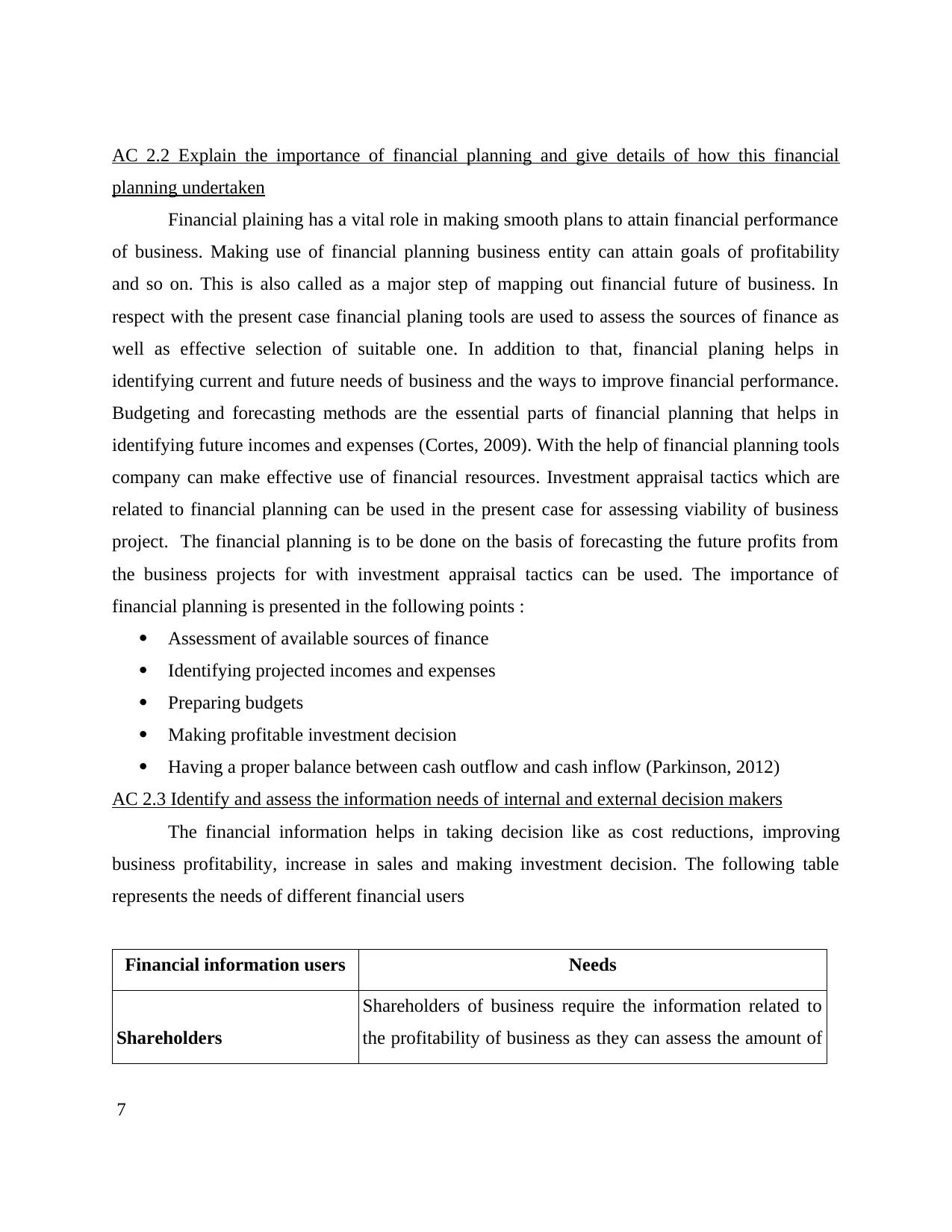
AC 2.2 Explain the importance of financial planning and give details of how this financial
planning undertaken
Financial plaining has a vital role in making smooth plans to attain financial performance
of business. Making use of financial planning business entity can attain goals of profitability
and so on. This is also called as a major step of mapping out financial future of business. In
respect with the present case financial planing tools are used to assess the sources of finance as
well as effective selection of suitable one. In addition to that, financial planing helps in
identifying current and future needs of business and the ways to improve financial performance.
Budgeting and forecasting methods are the essential parts of financial planning that helps in
identifying future incomes and expenses (Cortes, 2009). With the help of financial planning tools
company can make effective use of financial resources. Investment appraisal tactics which are
related to financial planning can be used in the present case for assessing viability of business
project. The financial planning is to be done on the basis of forecasting the future profits from
the business projects for with investment appraisal tactics can be used. The importance of
financial planning is presented in the following points :
Assessment of available sources of finance
Identifying projected incomes and expenses
Preparing budgets
Making profitable investment decision
Having a proper balance between cash outflow and cash inflow (Parkinson, 2012)
AC 2.3 Identify and assess the information needs of internal and external decision makers
The financial information helps in taking decision like as cost reductions, improving
business profitability, increase in sales and making investment decision. The following table
represents the needs of different financial users
Financial information users Needs
Shareholders
Shareholders of business require the information related to
the profitability of business as they can assess the amount of
7
planning undertaken
Financial plaining has a vital role in making smooth plans to attain financial performance
of business. Making use of financial planning business entity can attain goals of profitability
and so on. This is also called as a major step of mapping out financial future of business. In
respect with the present case financial planing tools are used to assess the sources of finance as
well as effective selection of suitable one. In addition to that, financial planing helps in
identifying current and future needs of business and the ways to improve financial performance.
Budgeting and forecasting methods are the essential parts of financial planning that helps in
identifying future incomes and expenses (Cortes, 2009). With the help of financial planning tools
company can make effective use of financial resources. Investment appraisal tactics which are
related to financial planning can be used in the present case for assessing viability of business
project. The financial planning is to be done on the basis of forecasting the future profits from
the business projects for with investment appraisal tactics can be used. The importance of
financial planning is presented in the following points :
Assessment of available sources of finance
Identifying projected incomes and expenses
Preparing budgets
Making profitable investment decision
Having a proper balance between cash outflow and cash inflow (Parkinson, 2012)
AC 2.3 Identify and assess the information needs of internal and external decision makers
The financial information helps in taking decision like as cost reductions, improving
business profitability, increase in sales and making investment decision. The following table
represents the needs of different financial users
Financial information users Needs
Shareholders
Shareholders of business require the information related to
the profitability of business as they can assess the amount of
7
Paraphrase This Document
Need a fresh take? Get an instant paraphrase of this document with our AI Paraphraser
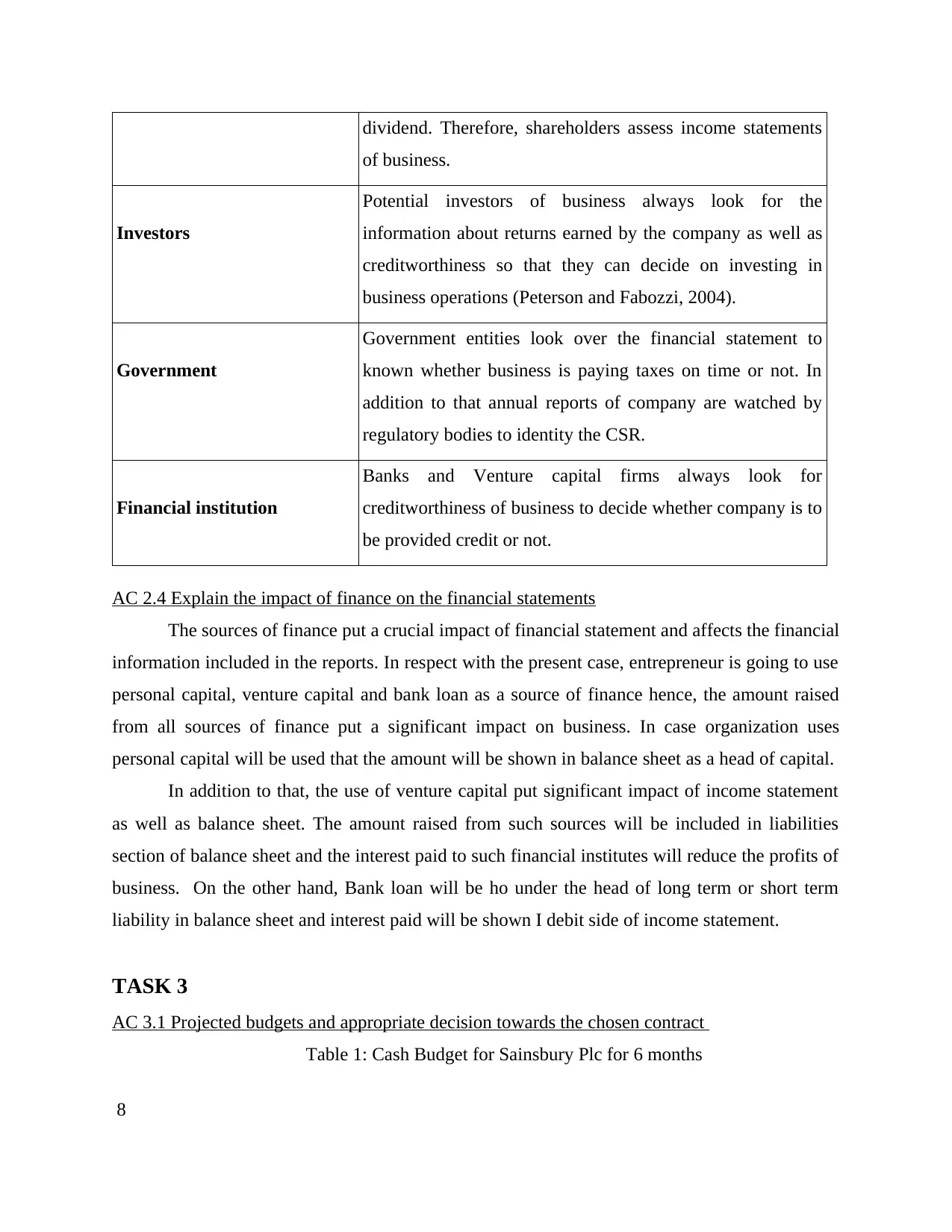
dividend. Therefore, shareholders assess income statements
of business.
Investors
Potential investors of business always look for the
information about returns earned by the company as well as
creditworthiness so that they can decide on investing in
business operations (Peterson and Fabozzi, 2004).
Government
Government entities look over the financial statement to
known whether business is paying taxes on time or not. In
addition to that annual reports of company are watched by
regulatory bodies to identity the CSR.
Financial institution
Banks and Venture capital firms always look for
creditworthiness of business to decide whether company is to
be provided credit or not.
AC 2.4 Explain the impact of finance on the financial statements
The sources of finance put a crucial impact of financial statement and affects the financial
information included in the reports. In respect with the present case, entrepreneur is going to use
personal capital, venture capital and bank loan as a source of finance hence, the amount raised
from all sources of finance put a significant impact on business. In case organization uses
personal capital will be used that the amount will be shown in balance sheet as a head of capital.
In addition to that, the use of venture capital put significant impact of income statement
as well as balance sheet. The amount raised from such sources will be included in liabilities
section of balance sheet and the interest paid to such financial institutes will reduce the profits of
business. On the other hand, Bank loan will be ho under the head of long term or short term
liability in balance sheet and interest paid will be shown I debit side of income statement.
TASK 3
AC 3.1 Projected budgets and appropriate decision towards the chosen contract
Table 1: Cash Budget for Sainsbury Plc for 6 months
8
of business.
Investors
Potential investors of business always look for the
information about returns earned by the company as well as
creditworthiness so that they can decide on investing in
business operations (Peterson and Fabozzi, 2004).
Government
Government entities look over the financial statement to
known whether business is paying taxes on time or not. In
addition to that annual reports of company are watched by
regulatory bodies to identity the CSR.
Financial institution
Banks and Venture capital firms always look for
creditworthiness of business to decide whether company is to
be provided credit or not.
AC 2.4 Explain the impact of finance on the financial statements
The sources of finance put a crucial impact of financial statement and affects the financial
information included in the reports. In respect with the present case, entrepreneur is going to use
personal capital, venture capital and bank loan as a source of finance hence, the amount raised
from all sources of finance put a significant impact on business. In case organization uses
personal capital will be used that the amount will be shown in balance sheet as a head of capital.
In addition to that, the use of venture capital put significant impact of income statement
as well as balance sheet. The amount raised from such sources will be included in liabilities
section of balance sheet and the interest paid to such financial institutes will reduce the profits of
business. On the other hand, Bank loan will be ho under the head of long term or short term
liability in balance sheet and interest paid will be shown I debit side of income statement.
TASK 3
AC 3.1 Projected budgets and appropriate decision towards the chosen contract
Table 1: Cash Budget for Sainsbury Plc for 6 months
8
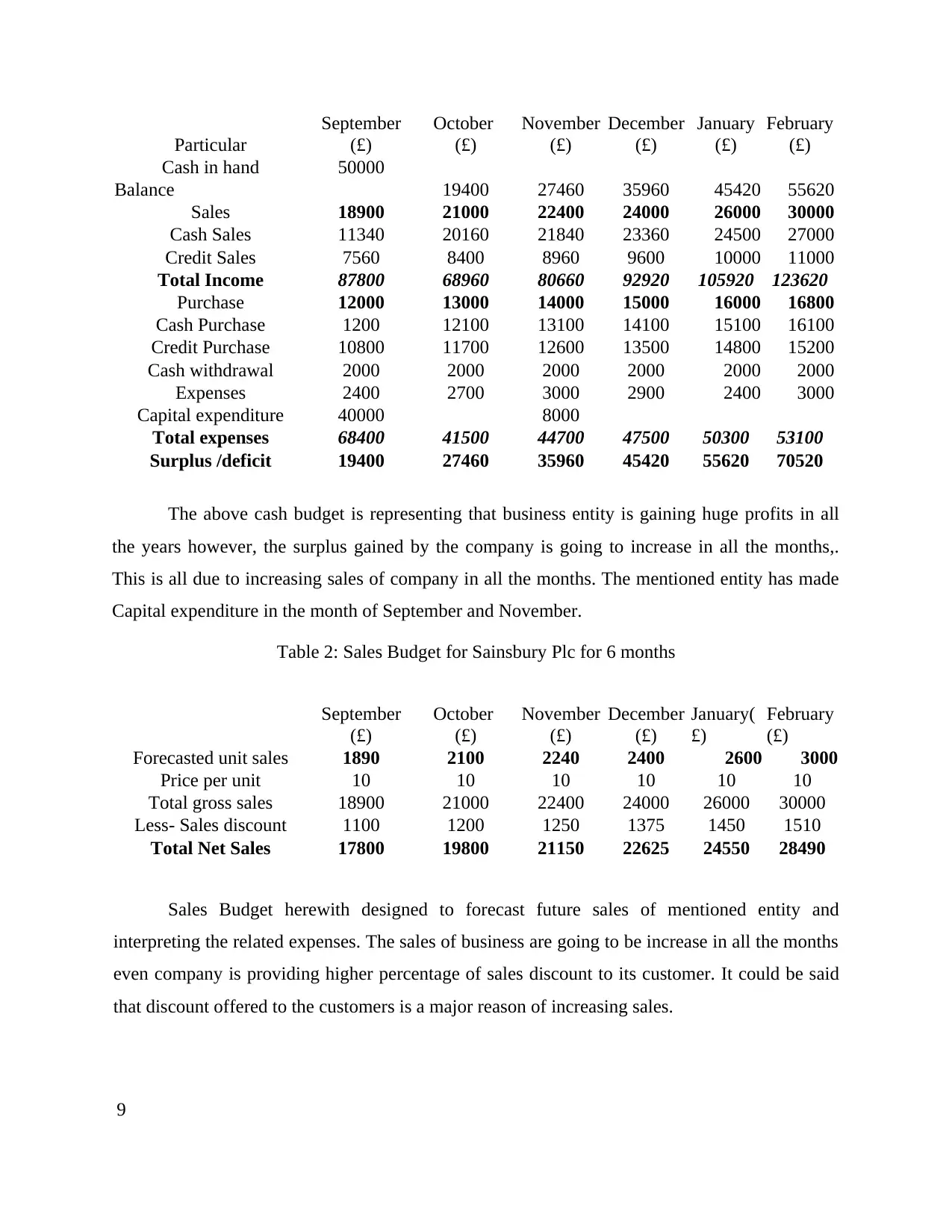
Particular
September
(£)
October
(£)
November
(£)
December
(£)
January
(£)
February
(£)
Cash in hand 50000
Balance 19400 27460 35960 45420 55620
Sales 18900 21000 22400 24000 26000 30000
Cash Sales 11340 20160 21840 23360 24500 27000
Credit Sales 7560 8400 8960 9600 10000 11000
Total Income 87800 68960 80660 92920 105920 123620
Purchase 12000 13000 14000 15000 16000 16800
Cash Purchase 1200 12100 13100 14100 15100 16100
Credit Purchase 10800 11700 12600 13500 14800 15200
Cash withdrawal 2000 2000 2000 2000 2000 2000
Expenses 2400 2700 3000 2900 2400 3000
Capital expenditure 40000 8000
Total expenses 68400 41500 44700 47500 50300 53100
Surplus /deficit 19400 27460 35960 45420 55620 70520
The above cash budget is representing that business entity is gaining huge profits in all
the years however, the surplus gained by the company is going to increase in all the months,.
This is all due to increasing sales of company in all the months. The mentioned entity has made
Capital expenditure in the month of September and November.
Table 2: Sales Budget for Sainsbury Plc for 6 months
September
(£)
October
(£)
November
(£)
December
(£)
January(
£)
February
(£)
Forecasted unit sales 1890 2100 2240 2400 2600 3000
Price per unit 10 10 10 10 10 10
Total gross sales 18900 21000 22400 24000 26000 30000
Less- Sales discount 1100 1200 1250 1375 1450 1510
Total Net Sales 17800 19800 21150 22625 24550 28490
Sales Budget herewith designed to forecast future sales of mentioned entity and
interpreting the related expenses. The sales of business are going to be increase in all the months
even company is providing higher percentage of sales discount to its customer. It could be said
that discount offered to the customers is a major reason of increasing sales.
9
September
(£)
October
(£)
November
(£)
December
(£)
January
(£)
February
(£)
Cash in hand 50000
Balance 19400 27460 35960 45420 55620
Sales 18900 21000 22400 24000 26000 30000
Cash Sales 11340 20160 21840 23360 24500 27000
Credit Sales 7560 8400 8960 9600 10000 11000
Total Income 87800 68960 80660 92920 105920 123620
Purchase 12000 13000 14000 15000 16000 16800
Cash Purchase 1200 12100 13100 14100 15100 16100
Credit Purchase 10800 11700 12600 13500 14800 15200
Cash withdrawal 2000 2000 2000 2000 2000 2000
Expenses 2400 2700 3000 2900 2400 3000
Capital expenditure 40000 8000
Total expenses 68400 41500 44700 47500 50300 53100
Surplus /deficit 19400 27460 35960 45420 55620 70520
The above cash budget is representing that business entity is gaining huge profits in all
the years however, the surplus gained by the company is going to increase in all the months,.
This is all due to increasing sales of company in all the months. The mentioned entity has made
Capital expenditure in the month of September and November.
Table 2: Sales Budget for Sainsbury Plc for 6 months
September
(£)
October
(£)
November
(£)
December
(£)
January(
£)
February
(£)
Forecasted unit sales 1890 2100 2240 2400 2600 3000
Price per unit 10 10 10 10 10 10
Total gross sales 18900 21000 22400 24000 26000 30000
Less- Sales discount 1100 1200 1250 1375 1450 1510
Total Net Sales 17800 19800 21150 22625 24550 28490
Sales Budget herewith designed to forecast future sales of mentioned entity and
interpreting the related expenses. The sales of business are going to be increase in all the months
even company is providing higher percentage of sales discount to its customer. It could be said
that discount offered to the customers is a major reason of increasing sales.
9
⊘ This is a preview!⊘
Do you want full access?
Subscribe today to unlock all pages.

Trusted by 1+ million students worldwide
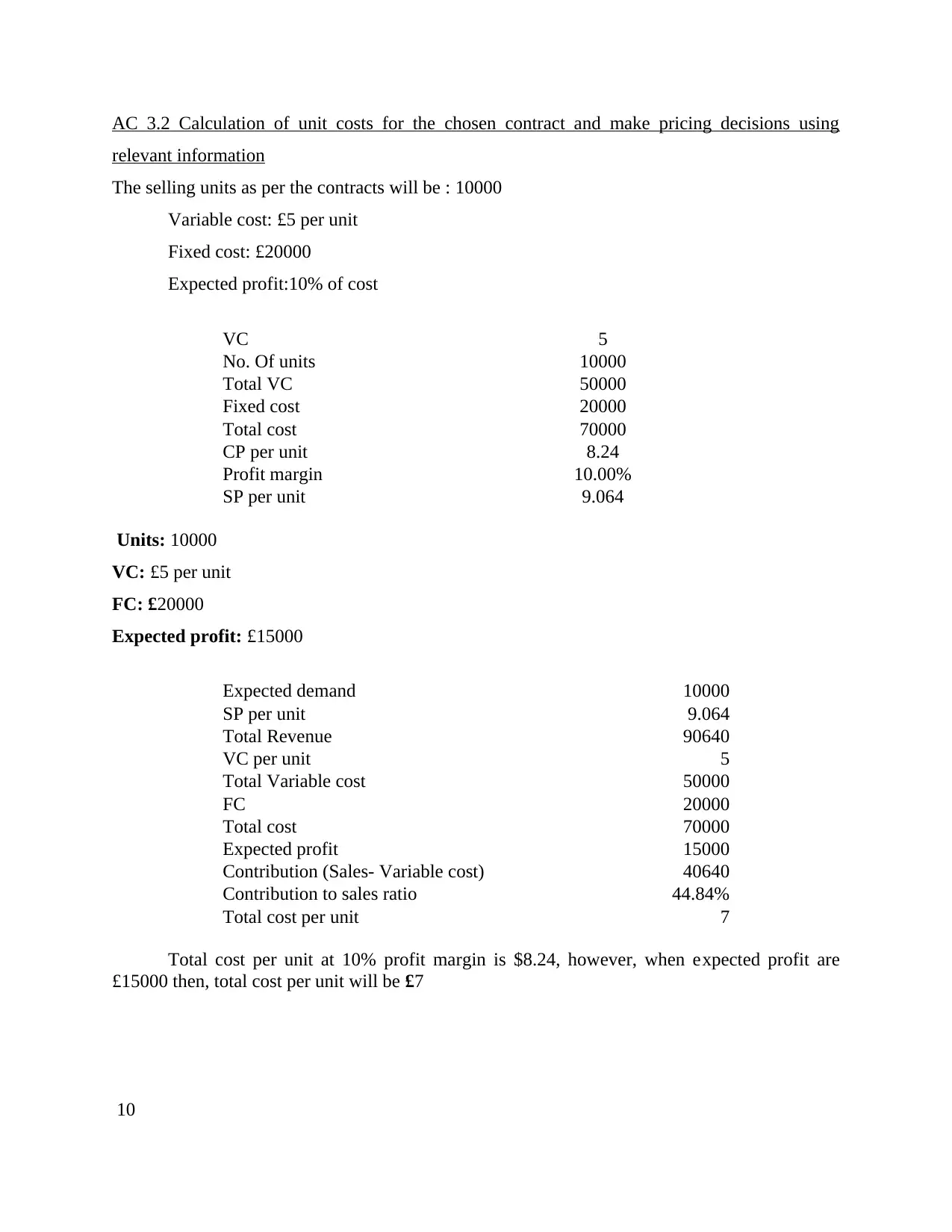
AC 3.2 Calculation of unit costs for the chosen contract and make pricing decisions using
relevant information
The selling units as per the contracts will be : 10000
Variable cost: £5 per unit
Fixed cost: £20000
Expected profit:10% of cost
VC 5
No. Of units 10000
Total VC 50000
Fixed cost 20000
Total cost 70000
CP per unit 8.24
Profit margin 10.00%
SP per unit 9.064
Units: 10000
VC: £5 per unit
FC: £20000
Expected profit: £15000
Expected demand 10000
SP per unit 9.064
Total Revenue 90640
VC per unit 5
Total Variable cost 50000
FC 20000
Total cost 70000
Expected profit 15000
Contribution (Sales- Variable cost) 40640
Contribution to sales ratio 44.84%
Total cost per unit 7
Total cost per unit at 10% profit margin is $8.24, however, when expected profit are
£15000 then, total cost per unit will be £7
10
relevant information
The selling units as per the contracts will be : 10000
Variable cost: £5 per unit
Fixed cost: £20000
Expected profit:10% of cost
VC 5
No. Of units 10000
Total VC 50000
Fixed cost 20000
Total cost 70000
CP per unit 8.24
Profit margin 10.00%
SP per unit 9.064
Units: 10000
VC: £5 per unit
FC: £20000
Expected profit: £15000
Expected demand 10000
SP per unit 9.064
Total Revenue 90640
VC per unit 5
Total Variable cost 50000
FC 20000
Total cost 70000
Expected profit 15000
Contribution (Sales- Variable cost) 40640
Contribution to sales ratio 44.84%
Total cost per unit 7
Total cost per unit at 10% profit margin is $8.24, however, when expected profit are
£15000 then, total cost per unit will be £7
10
Paraphrase This Document
Need a fresh take? Get an instant paraphrase of this document with our AI Paraphraser
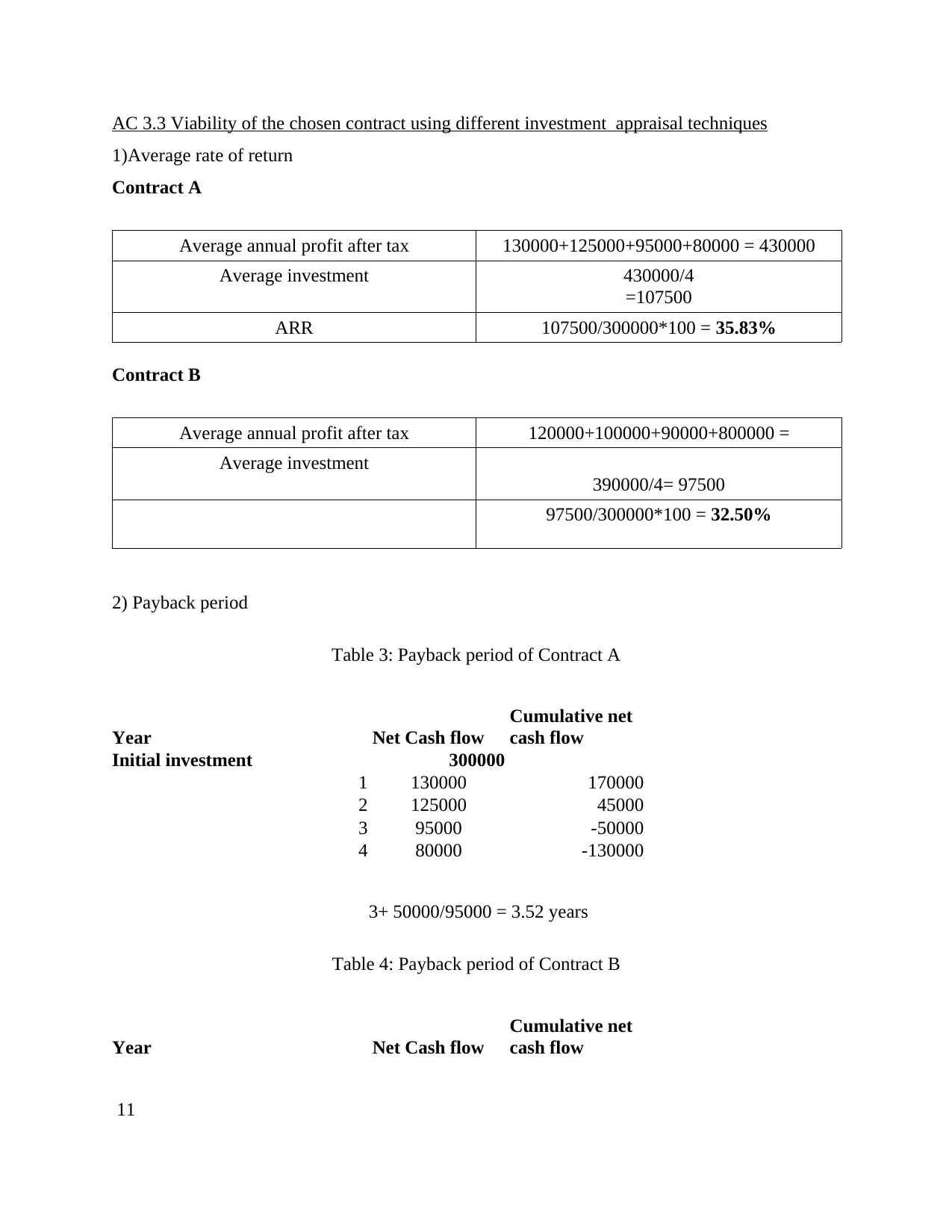
AC 3.3 Viability of the chosen contract using different investment appraisal techniques
1)Average rate of return
Contract A
Average annual profit after tax 130000+125000+95000+80000 = 430000
Average investment 430000/4
=107500
ARR 107500/300000*100 = 35.83%
Contract B
Average annual profit after tax 120000+100000+90000+800000 =
Average investment
390000/4= 97500
97500/300000*100 = 32.50%
2) Payback period
Table 3: Payback period of Contract A
Year Net Cash flow
Cumulative net
cash flow
Initial investment 300000
1 130000 170000
2 125000 45000
3 95000 -50000
4 80000 -130000
3+ 50000/95000 = 3.52 years
Table 4: Payback period of Contract B
Year Net Cash flow
Cumulative net
cash flow
11
1)Average rate of return
Contract A
Average annual profit after tax 130000+125000+95000+80000 = 430000
Average investment 430000/4
=107500
ARR 107500/300000*100 = 35.83%
Contract B
Average annual profit after tax 120000+100000+90000+800000 =
Average investment
390000/4= 97500
97500/300000*100 = 32.50%
2) Payback period
Table 3: Payback period of Contract A
Year Net Cash flow
Cumulative net
cash flow
Initial investment 300000
1 130000 170000
2 125000 45000
3 95000 -50000
4 80000 -130000
3+ 50000/95000 = 3.52 years
Table 4: Payback period of Contract B
Year Net Cash flow
Cumulative net
cash flow
11
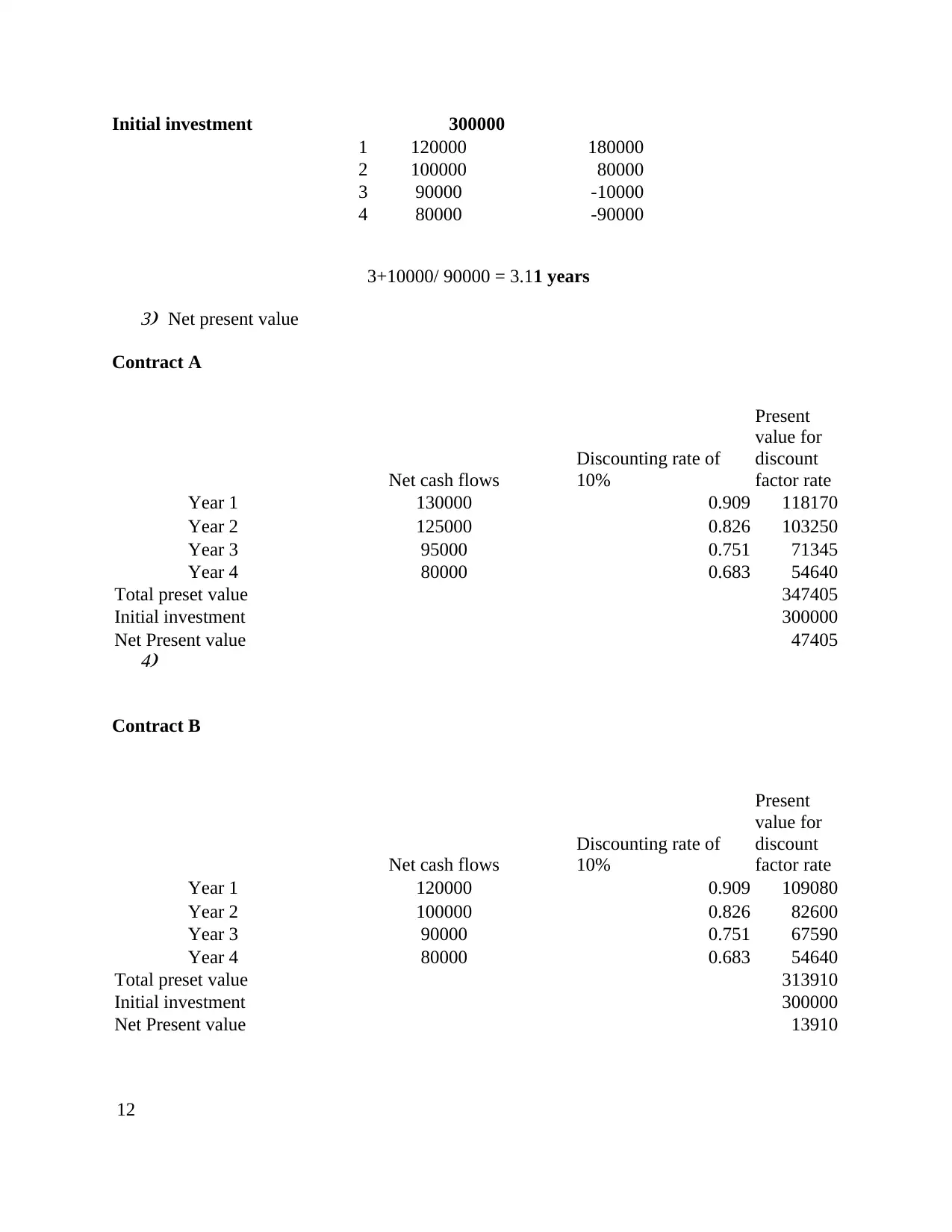
Initial investment 300000
1 120000 180000
2 100000 80000
3 90000 -10000
4 80000 -90000
3+10000/ 90000 = 3.11 years3) Net present value
Contract A
Net cash flows
Discounting rate of
10%
Present
value for
discount
factor rate
Year 1 130000 0.909 118170
Year 2 125000 0.826 103250
Year 3 95000 0.751 71345
Year 4 80000 0.683 54640
Total preset value 347405
Initial investment 300000
Net Present value 47405
4)
Contract B
Net cash flows
Discounting rate of
10%
Present
value for
discount
factor rate
Year 1 120000 0.909 109080
Year 2 100000 0.826 82600
Year 3 90000 0.751 67590
Year 4 80000 0.683 54640
Total preset value 313910
Initial investment 300000
Net Present value 13910
12
1 120000 180000
2 100000 80000
3 90000 -10000
4 80000 -90000
3+10000/ 90000 = 3.11 years3) Net present value
Contract A
Net cash flows
Discounting rate of
10%
Present
value for
discount
factor rate
Year 1 130000 0.909 118170
Year 2 125000 0.826 103250
Year 3 95000 0.751 71345
Year 4 80000 0.683 54640
Total preset value 347405
Initial investment 300000
Net Present value 47405
4)
Contract B
Net cash flows
Discounting rate of
10%
Present
value for
discount
factor rate
Year 1 120000 0.909 109080
Year 2 100000 0.826 82600
Year 3 90000 0.751 67590
Year 4 80000 0.683 54640
Total preset value 313910
Initial investment 300000
Net Present value 13910
12
⊘ This is a preview!⊘
Do you want full access?
Subscribe today to unlock all pages.

Trusted by 1+ million students worldwide
1 out of 18
Related Documents
Your All-in-One AI-Powered Toolkit for Academic Success.
+13062052269
info@desklib.com
Available 24*7 on WhatsApp / Email
![[object Object]](/_next/static/media/star-bottom.7253800d.svg)
Unlock your academic potential
Copyright © 2020–2025 A2Z Services. All Rights Reserved. Developed and managed by ZUCOL.





